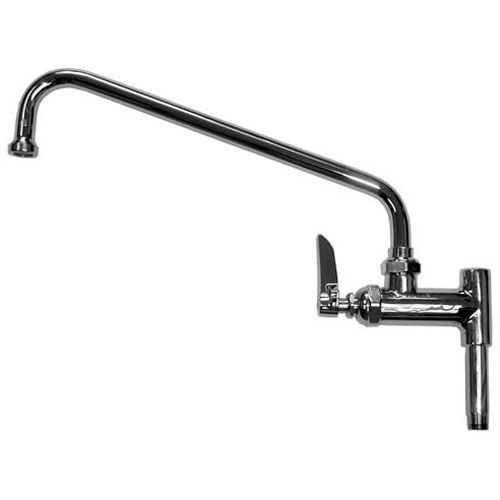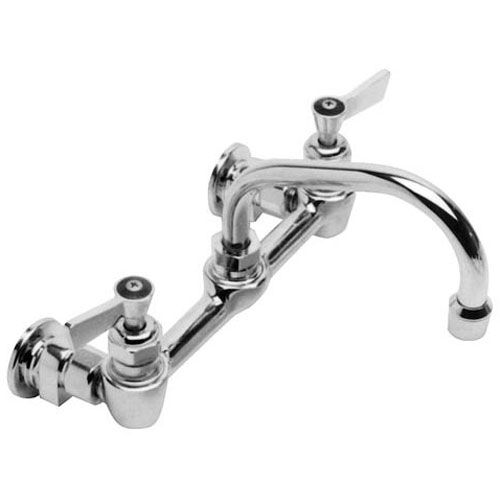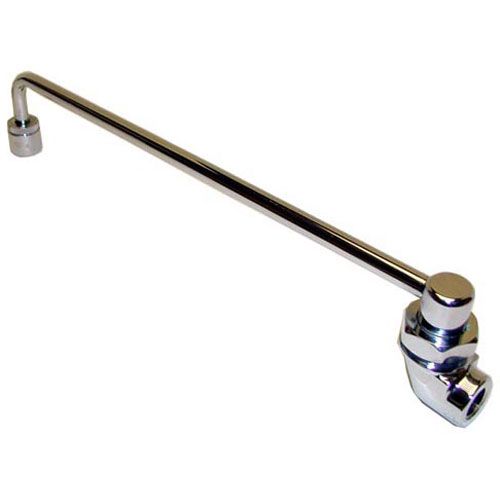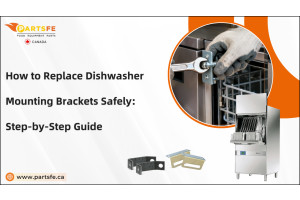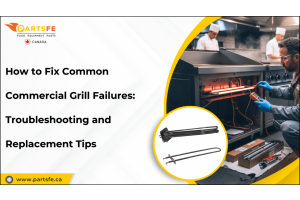Commercial Kitchen Pre-Rinse Faucets: How to Make the Right Choices
Choosing the right pre-rinse faucet for a commercial kitchen is essential for maintaining efficiency, hygiene, and durability in a high-demand environment. With so many options available, each varying in design, functionality, and features, it can be challenging to know which model will best suit your kitchen’s needs. From water pressure and spray patterns to installation types and compliance standards, several factors must be considered before making a purchase. In this guide, we’ll walk you through the key aspects to evaluate when selecting commercial pre-rinse faucet parts. Whether you’re outfitting a new kitchen or upgrading an existing setup, understanding your options will help you make a smart investment that improves workflow and withstands the demands of a busy commercial kitchen.
What is a Pre-Rinse Faucet and Why is it Essential in Commercial Kitchens
A pre-rinse faucet is a specialized fixture used in commercial kitchens to rinse food debris from dishes before final washing. It features a high-pressure spray nozzle connected to a flexible hose, allowing staff to quickly and efficiently clean dishes. This type of faucet is essential in busy environments where time, hygiene, and efficiency matter.
Key Features of a Pre-Rinse Faucet:
-
High-Pressure Spray Nozzle: A high-pressure spray nozzle quickly and effectively removes stuck-on food.
-
Flexible Hose with Spring Support: The flexible hose with spring support provides easy mobility and maneuverability.
-
Ergonomic Design: When used frequently, an ergonomic design lessens the strain on kitchen staff.
-
Temperature Control: Temperature control features enhance safety in busy kitchen environments.
-
Low-Flow: Low-flow options conserve water without sacrificing cleaning power.
Why it’s Essential in Commercial Kitchens:
-
Boosts Cleaning Efficiency: Pre-rinse faucets speed up the dishwashing process by quickly removing food debris, reducing the need for scrubbing.
-
Improves Hygiene: They ensure dishes are thoroughly rinsed before washing, helping maintain high sanitation standards in busy kitchens.
-
Protect Equipment: By removing leftover food early, these faucets help prevent clogs and damage to dishwashers and plumbing systems.
-
Saves Time And Labor: Their easy maneuverability and powerful spray reduce manual effort, making them perfect for fast-paced kitchen environments.
-
Supports Sustainability: Many pre-rinse faucets feature low-flow technology to conserve water without compromising cleaning performance.
Overall, a pre-rinse faucet is a vital investment for maintaining a fast, clean, and cost-effective commercial kitchen.
Looking for reliable commercial kitchen pre-rinse faucet parts? PartsFeCA offers top-quality spray valves, hoses, and washers from trusted brands like T&S Brass, Randell, and Fisher. Shop now to ensure your kitchen runs smoothly with durable, high-performance components!
Key Components to Consider When Choosing a Commercial Pre-Rinse Faucet
When selecting a commercial pre-rinse faucet, understanding its key components is crucial for ensuring durability, performance, and ease of maintenance. Each part plays a specific role in the faucet’s operation and longevity.
-
Washers: These small, flat components help seal connections and prevent water leakage at key joints in the faucet.
-
Rubber Washers: Made from flexible rubber, they provide cushioning and sealing in moving parts like handles and joints.
-
O-Rings: Circular sealing elements that help maintain water-tight connections within the faucet assembly.
-
Escutcheon Plates: Decorative covers that conceal the mounting hole and protect surfaces from water exposure.
-
Quick Disconnect Fittings: Allow for fast, tool-free disconnection of the hose or spray valve for easier maintenance.
-
Stainless Steel Hose: A durable, flexible hose that withstands constant use and high water pressure in commercial kitchens.
-
Atmospheric Vacuum Breaker: A safety mechanism that stops tainted water from returning to the clean water source.
-
Hose Assembly: The complete hose unit that links the spray valve to the faucet’s main body and water source.
-
Diverter Valves: Redirect water flow between the faucet spout and the pre-rinse spray valve as needed.
-
Hose Spring Guard: A coiled guard that protects the hose from bending or kinking during regular use.
-
Pre-Rinse Spray Valve: Provides a concentrated, high-pressure spray to rinse food debris from dishes efficiently.
-
Spray Handle: The trigger-style handle used to control the spray valve, offering a comfortable grip and control.
-
Vacuum Breaker Assembly: An integrated backflow prevention system built into the faucet for added water safety.
-
Gasket Kits: Collections of seals and gaskets used to replace or reinforce water-tight connections within the faucet.
-
Spray Valve Assembly: The entire spray valve unit, typically including the valve body, nozzle, and trigger mechanism.
-
Adapters & Fittings: Connectors that ensure compatibility between different faucet parts or plumbing systems.
-
O-Rings & Gaskets: Used throughout the faucet to ensure sealed, leak-free joints in moving and static parts.
Different Types of Pre-Rinse Faucets and Their Applications
Commercial pre-rinse faucets come in various types, each suited to different kitchen setups and operational needs. Here are the main types and their typical applications:
Wall-Mounted Pre-Rinse Faucet
Mounted directly to the wall, this type keeps counters clear and works well in kitchens with existing wall plumbing.
Applications:
-
Ideal for commercial kitchens with limited counter space.
-
Common in restaurants and institutional food service operations.
-
Great for back-of-house setups with wall-mounted utilities.
Deck-Mounted Pre-Rinse Faucet
Installed on the sink or countertop, offering flexibility and easier access to plumbing during installation or repairs.
Applications:
-
Suitable for spacious workstations or islands.
-
Preferred in setups that require frequent faucet servicing.
-
Common in prep stations with built-in sink counters.
Single-Handle Pre-Rinse Faucet
Enables quick, one-handed operation with a single handle for controlling the hot and cold water.
Applications:
-
Perfect for high-volume environments like fast-food kitchens.
-
Useful where staff frequently multitask.
-
Reduces time spent adjusting water temperature.
Dual-Handle Pre-Rinse Faucet
Includes separate hot and cold handles for more precise temperature control and balance.
Applications:
-
Ideal for kitchens needing temperature precision (e.g., bakeries, catering).
-
Helpful in colder regions for balancing water temperature.
-
Useful when water temperature impacts cleaning effectiveness.
Low-Flow / Eco-Friendly Pre-Rinse Faucet
Designed to reduce water consumption without compromising spray strength or cleaning performance.
Applications:
-
Perfect for environmentally conscious restaurants and cafes.
-
Ideal for commercial settings aiming to meet sustainability goals.
-
Recommended where water usage needs to be monitored or reduced.
Each type supports different tasks from light rinsing in cafés to heavy-duty dishwashing in large commercial kitchens. Choosing the right faucet ensures better workflow, hygiene, and long-term durability.
How to Troubleshoot Common Pre-Rinse Faucet Parts Issues
Even high-quality commercial pre-rinse faucet parts can experience wear and tear over time. Knowing how to identify and fix common issues helps prevent downtime and costly repairs:
Issue: Leaking at the spray valve
Cause: Worn washers or damaged o-rings often cause leaks around the spray valve.
Fixes:
-
Replace the washers and O-rings with new ones.
-
Tighten any loose connections around the spray valve.
-
Clean the valve area to remove debris that may affect the seal.
Issue: Loose or malfunctioning spray handle
Cause: A broken trigger mechanism or weakened internal spring can cause handling problems.
Fixes:
-
Replace the trigger or internal spring components.
-
Check and tighten handle screws and fasteners.
-
Lubricate moving parts to ensure smooth handling action.
Issue: Loss of water pressure
Cause: A clogged spray valve or a blocked aerator reduces water flow and pressure.
Fixes:
-
Remove and clean the spray valve to clear the buildup.
-
If required, clean or replace the aerator.
-
Check supply lines for obstacles or kinks.
Issue: Leaks at the base or mounting point
Cause: Worn gaskets or loose fittings cause water to leak around the faucet base.
Fixes:
-
Replace worn gaskets or seals under the base.
-
Tighten mounting nuts or screws securing the faucet.
-
Apply plumber’s tape to threaded fittings for a tighter seal.
Issue: Backflow problems
Cause: A faulty or clogged vacuum breaker assembly allows contaminated water to flow backward.
Fixes:
-
Clean the vacuum breaker assembly to remove debris.
-
Replace the vacuum breaker if it is damaged or worn out.
-
To ensure the proper operation, test the assembly on a regular basis.
Issue: Cracks or loose connections in hose assemblies and fittings
Cause: Wear and tear or improper installation can cause cracks or loose fittings.
Fixes:
-
Inspect hoses regularly and replace any cracked or damaged sections.
-
Tighten quick disconnect fittings and adapters.
-
Use compatible parts to avoid stress on connections.
Check out this guide on common restaurant sink drain plumbing problems: here's how to fix to identify and solve issues that often affect commercial kitchen performance.
Installation Tips for Pre-Rinse Faucets in Commercial Settings
Installing a pre-rinse faucet correctly is crucial for ensuring its long-term performance and efficiency in a busy commercial kitchen. If you’re wondering how to install a pre-rinse faucet, following these essential tips can make the process smoother and more reliable:
-
To prevent leaks or mishaps during installation, turn off the water supply before beginning.
-
Check the mounting location carefully, whether it’s wall-mounted or deck-mounted, ensuring the area is clean and accessible.
-
Measure twice to ensure proper alignment before drilling holes or securing mounting hardware.
-
Use plumber’s tape on threaded connections when attaching water supply lines to prevent leaks and ensure a tight seal.
-
Connect hot and cold water lines correctly to maintain consistent temperature control.
-
Install the vacuum breaker assembly according to the manufacturer's guidelines to prevent backflow contamination.
-
After assembling all parts, slowly turn the water back on and check for leaks or loose fittings.
-
Test the spray valve and handle to ensure smooth operation.
By following these steps, you can ensure your commercial kitchen faucet parts operate efficiently, reducing downtime and maintaining hygiene standards.
Also, check out this detailed guide on how to replace faulty kitchen sink drain parts to keep your sink setup sealed, leak-free, and running smoothly.
Maintenance and Cleaning Tips to Extend Faucet Lifespan
Proper maintenance and regular cleaning are essential to extend the lifespan of commercial pre-rinse faucet parts. These faucets face heavy daily use and exposure to grease, food particles, and hard water, which can cause buildup and wear if neglected.
-
Regular Cleaning: Routinely wipe down the faucet using a mild detergent and warm water to remove grease and food debris. This keeps the surface clean and stops accumulation.
-
Avoid Harsh Chemicals: Avoid using harsh chemicals or abrasive cleaners since they might shorten the faucet's lifespan and harm its finish. Instead, use mild cleaning solutions.
-
Focus on High-Use Parts: Give extra attention to cleaning the spray valve and handle since these parts are frequently touched and prone to grime accumulation.
-
Inspect Seals and Washers: Frequently check washers, o-rings, and gaskets for signs of wear or leaks. Replacing worn parts early can prevent persistent leaks and water wastage.
-
Check Hose and Fittings: Examine the hose assembly and fittings regularly for any cracks or loose connections. Tighten or replace parts to avoid leaks and maintain water pressure.
-
Descale for Hard Water: In areas with hard water, periodically descale the faucet using a vinegar solution or a safe commercial descaler to prevent mineral buildup in nozzles.
-
Test Vacuum Breaker: Make that the vacuum breaker assembly is operating correctly by testing it on a regular basis. This helps prevent backflow contamination and maintains safe water quality.
By following these maintenance and cleaning tips, you can keep your pre-rinse faucet working efficiently and extend its operational life.
In conclusion, selecting the right commercial kitchen pre-rinse faucet parts and understanding them are essential for optimizing kitchen efficiency and hygiene. Proper installation, regular maintenance, and timely troubleshooting not only extend the faucet’s lifespan but also prevent costly disruptions in busy kitchen operations. By investing in quality components and following best practices, commercial kitchens can ensure consistent performance, conserve water, and maintain a clean, safe environment. Ultimately, making informed choices about your pre-rinse faucet supports long-term savings and enhances the overall workflow of your kitchen.
FAQs
What is the difference between a pre-rinse faucet and a regular faucet?
Pre-rinse faucets feature a high-pressure spray nozzle and flexible hose designed for quickly rinsing food debris before washing, while a regular faucet typically provides a steady water flow for general use. Pre-rinse faucets are built for heavy-duty commercial kitchen tasks, offering greater reach and power.
What size thread is a commercial faucet?
Most commercial faucets use a ½-inch or ¾-inch threaded connection, depending on the plumbing setup and manufacturer specifications. It’s important to check the specific faucet model to ensure compatibility with your water supply lines.
What type of valve is best for a kitchen faucet?
Ceramic disc valves are considered the best for kitchen faucets because they offer smooth operation and long-lasting durability without leaks. They outperform traditional rubber washer valves by providing a tighter seal and requiring less maintenance.
Are commercial faucets with pre-rinse sprayers water-efficient?
Yes, many models come with low-flow options that conserve water without compromising the power of the spray.


